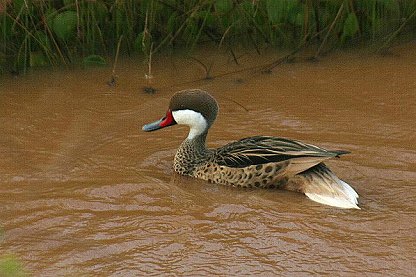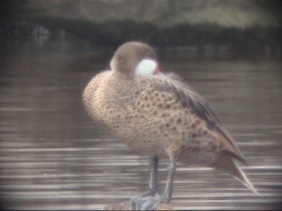|
White-cheeked Pintail Anas bahamensis Pato Quijada Colorada,
|
 |
|
Photo: B. Hallett
|
|
IDENTIFICATION: A brown duck with a white "cheek" and throat. The base of the upper bill is bright red. Length: 38-51 cm.; weight: 474-533 g. VOICE: A soft quacking note. Audio ( M. Oberle). HABITAT: Fresh and salt water ponds, lagoons and mangrove swamps. HABITS: The White-cheeked Pintail travels in small flocks and feeds on seeds and leaves of algae and other aquatic plants. It dips its head into the water or occasionally dives for food. It nests on the ground in dense vegetation near water. The female lays 5-12 eggs. The incubation period is about 25 days. Besides plant material, the young birds also eat snails and insects, such as water boatmen. White-cheeked Pintail have recently been documented traveling back and forth between Culebra Island and the Humacao marshes in eastern Puerto Rico. STATUS AND CONSERVATION: Although common elsewhere in the West Indies, the population in Puerto Rico is estimated at only about 1,000 birds. Most are found on the eastern end of the island from Yabucoa to Fajardo, as well as on Culebra and Vieques. They are also found in the west, e.g., at Punta Guaniquilla, Caño Tiburones Nature Reserve and Boquerón Wildlife Refuge. Destruction of wetlands, the introduction of the mongoose, and hunting all contributed to the decline of this species. It is now protected in Puerto Rico. Many pintails have been marked with leg bands, colored clips on the bill, and /or transmitters to track their movements. If you see a marked bird of any species, please report it to the Depto. de Recursos Naturales y Ambientales (787-724-8774). RANGE: Breeds in the northern West Indies, and northern South America, and also in northern Argentina and southern Brazil. The population in the West Indies is sedentary. Regular places to find this bird include the ponds at the Humacao Nature Reserve, and Flamenco Lagoon on Culebra. TAXONOMY: ANSERIFORMES; ANATIDAE; Anatinae |
|




